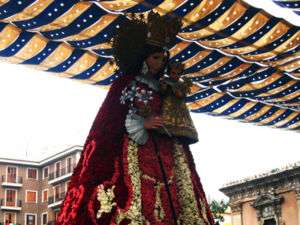Amparo (name)
Amparo is a Portuguese and Spanish word which means refuge or shelter (and in a broader sense, protection). Several places in the Iberian Peninsula and in Latin America are named Amparo, some of them associated with the devotion of Our Lady of the Refuge (Port.: Nossa Senhora do Amparo, Esp: Nuestra Señora del Amparo).
Meaning
This forename is quite common in Valencia, Spain. The city is dedicated to La virgen de los desamparados, the patron saint of the city of Valencia.
Origin
On 24 February 1409, the Venerable Joan Gilabert Jofré of the Military Order of Our Lady of Mercy, was en route to Valencia's Cathedral to deliver a Lenten sermon when he witnessed a mentally ill man being lynched on a street. In response, his Order founded a hospice in 1410 with help from generous Roman Catholic confreres for the mentally ill under the invocation of Sancta dels Folls Doña Nostra i Desamparats Innocents (Our Lady of the insane and the innocent; sometimes translated as Our Lady of the forsaken), whose goal was to help people with mental illness. It has been claimed that this was the first psychiatric hospital in the world.[1][2] Due to the famine of the period and the high rate of orphans due to the plague, the streets were filled with orphans. The hospice was soon expanded to assist orphans and foundlings, many the result of the plague.[3]
The image of the virgin of the forsaken

In 1414 three young pilgrims offered to make a sculpture of Sancta dels Folls Dona Nostra and Desamparats Innocents. The image would become the Mare de Déu dels Folls, Innocents i Desemparats, dedicated to the Virgin Mary, who is represented with a lily in one hand and the baby Jesus carrying the cross in his arms in the other hand. The image is characterized by a slight forward tilt, and she is known affectionately as "The Geperudeta" ("the hunchback"). The growing devotion to the image of Our Lady of the Forsaken forced a search for a more suitable place. As a result of the plague in Valencia in 1647 which claimed more than 18,000 lives, prayers were made to the Virgin Mary for help and protection. When the city recovered, work began in 1652 to give shelter to the Virgin, who was already then considered the mother of all Valencia.
References
- ↑
- ↑ (in Spanish)
- ↑ Background on Father Jofré